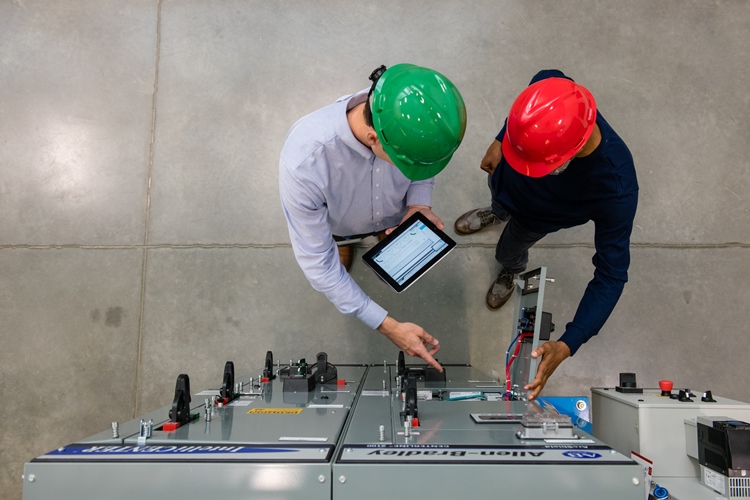When looking at the different functions across an industrial enterprise today, think product and machine design, production engineering, plant operations, and supply chain, you will find many legacy software applications where data is locked up. For manufacturers, data siloes typically build up in systems used for day-to-day planning and operations, including enterprise resource planning (ERP), electronic manufacturing services (EMS), manufacturing execution systems (MES), manufacturing operations management (MOM), or other software systems and tools, says Keith Higgins, VP of digital transformation, Rockwell Automation.
It is challenging to build the connectivity to join these environments, and as a result, a lot of these critical functions remain siloed. However, when the various enterprise systems are not integrated across an organisation, manufacturers may miss critical insights that could improve factory operations. As Rockwell Automation CTO Sujeet Chand highlighted at our recent Automation Fair at Home event, “as we move further into the digital age, it is critical that organisations tie these siloed functions together digitally to get operational value from their digital transformation initiatives.”
Over 60% of manufacturers are planning to increase their investments in smart factory initiatives over the next few years. That ratio will undoubtedly increase as existing digital transformation projects scale up and new cutting-edge enterprise technology solutions emerge over the next few years. To ensure the best business outcomes, it is important manufacturers move beyond traditional siloed data approaches with a digital thread strategy.
Digital thread: tying enterprises together
By utilising open standards, and new technologies, such as virtualisation cloud, organisations can bring together these different disparate pieces in an enterprise to drive business value. This is the purpose of digital thread. Digital thread is a strategic framework that optimises the lifecycle of a product, asset, system, or process by connecting critical business functions.

Connecting ERP, EMS, MES, and MOM systems via a digital thread allows information to flow between systems to inform and optimise business-driving processes ranging from design, to supply chain, to production. This approach provides the entire value chain with access to unified digital data captured during design, virtual simulation, and physical operations. A holistic digital strategy, powered by digital thread, helps manufacturers move faster by removing friction between disparate teams and systems.
Think of a digital thread as a record of the evolution of your manufacturing operations. From physical machines, to manufacturing processes, to automation code and maintenance steps, digital thread provides visibility into their past, present, and future states. This increased visibility into the evolution lifecycle helps to prevent digital transformation disruptions and upsets – ultimately enabling accelerated innovation, maximised workforce productivity, and optimised operations.
Digital thread offers three potential areas of business value:
- Innovation: Digital thread enables accelerated innovation through real-time collaboration. Manufacturers no longer need to email design files across their organisation, accepting that there will inevitably be version control issues. Machine builder engineers, who are designing the machine, and field engineers on site establish a single source of truth by exchanging information in real-time.
- Operations: Digital thread can be used to commission new production lines virtually enabling manufacturers to decrease time to market and protect investments. Rather than waiting to commission manufacturing lines until the machinery is bolted to the plant floor, manufacturers can ensure that operations will run smoothly by validating manufacturing processes and debugging a programmable logic controller (PLC) code via a digital twin.
- Training: Digital thread maximises the potential productivity of the manufacturing workforce by equipping employees with the tools they need. From veterans to new hires, digital thread connects business systems together to enable the creation of a historical record of all trainings and on-the-job instructions needed to keep production running smoothly. Virtual reality and augmented reality can shorten training time by as much as 75% by enabling low-risk, high-fidelity environment training and real-time equipment instruction for new or retrained employees.

All this information regarding machine performance, employee training, and real-time collaboration is stored within the digital thread maintaining the context of data and enabling rapid operations insights to bring manufacturers to peak performance in record time. This contextualisation of information drastically reduces the time and effort needed to integrate production lines into existing business processes, the time to develop high-value software applications, and the risk associated with changes to the production line.
Manufacturers seeking to realise their full digital potential and reap highest ROI when it comes to digital transformation must futureproof their digitisation investments and re-think the way they manage operations by leveraging digital thread. In the end, this will enable manufacturers to monitor operations and apply learnings from their production lines safer and faster than ever before.
The author is Keith Higgins, VP of digital transformation, Rockwell Automation.
About the author
Keith Higgins is vice president of digital transformation at Rockwell Automation, a global provider of industrial automation and digital transformation. He previously served as vice president at FogHorn and CMO at RiskVision until its acquisition in 2017.
Comment on this article below or via Twitter: @IoTNow_OR @jcIoTnow










